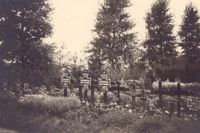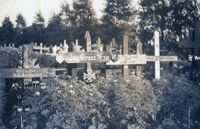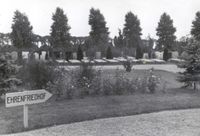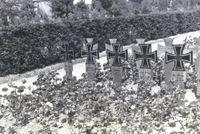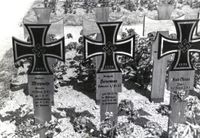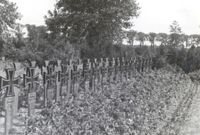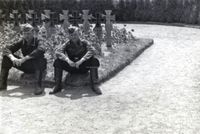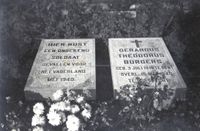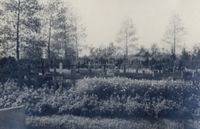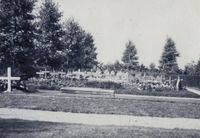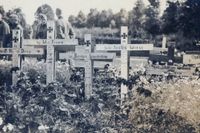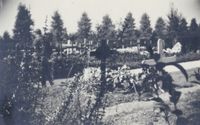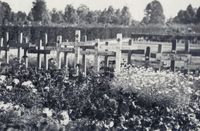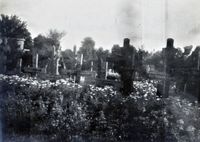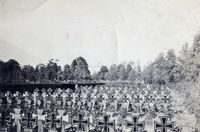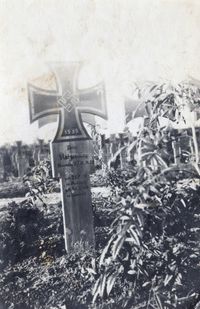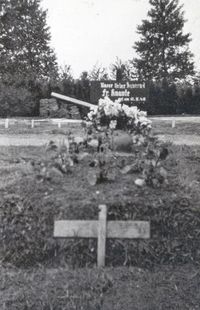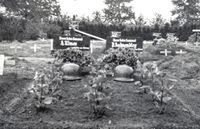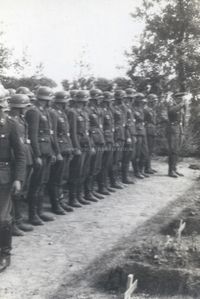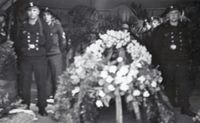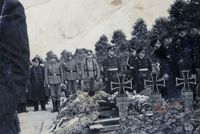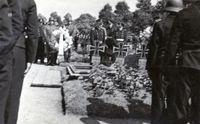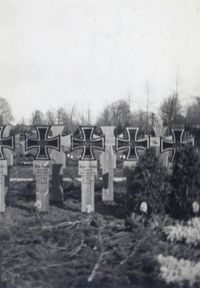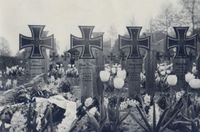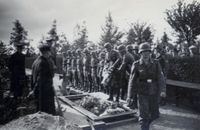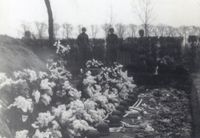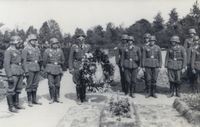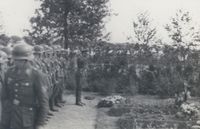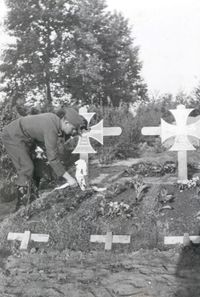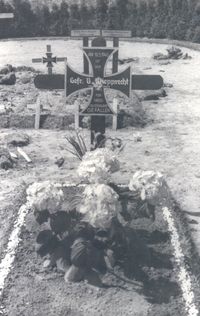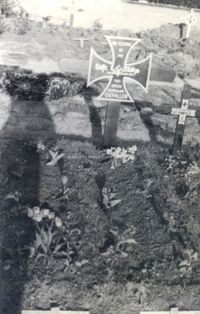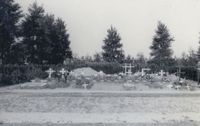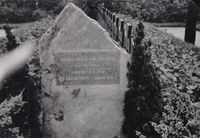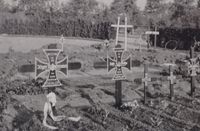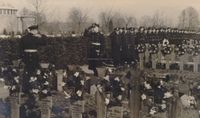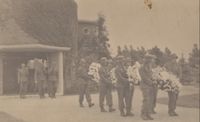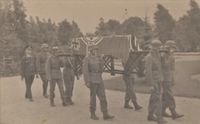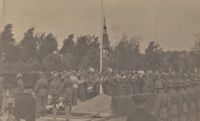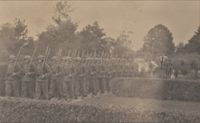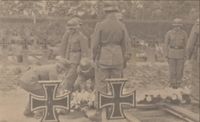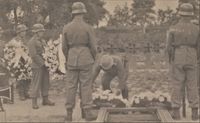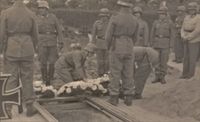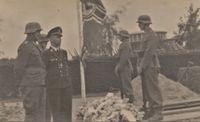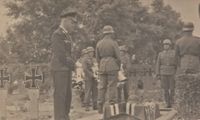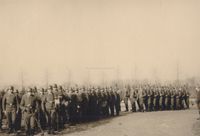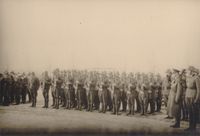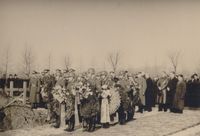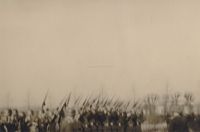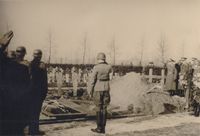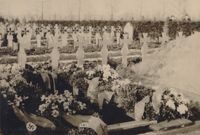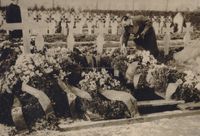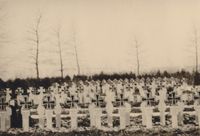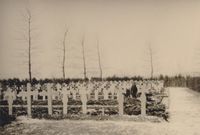The general cemetery in Dordrecht.
During May 1940, many German soldiers were killed in Dordrecht and the surrounding area. Makeshift emergency and field graves for German soldiers were scattered throughout the island. Since the German regime perhaps did not have the means or, more likely, did not have the intention to repatriate these fallen soldiers to Germany, they were often given a permanent burial in local cemeteries. The cemetery in Krispijn is an example of this. The number of Dutch casualties was not insignificant either. In most cases, they too were laid to rest permanently in the cemetery in Dordrecht. In the case of Dutch soldiers, there were sometimes instances where they were transferred to their place of birth or residence to be buried. During the war, German graves were added to the cemetery as well, such as those of wounded soldiers who died in Dordrecht hospitals or victims of bombings or battles in the region. After the liberation, there was a general aversion towards the Germans and little sympathy for the numerous German graves that our country had acquired. Eventually, almost all German soldiers were transferred to Ysselsteyn in the province of Limburg, where most of them are now buried. The initial German graves were marked with small wooden crosses, presumably displaying the soldier's identification tag number. Soon, there emerged a variation of grave markers. These were likely made and placed by the soldiers themselves. By the spring of 1941, all German graves were marked with an identical type of marker in the form of an iron cross. Initially, Dutch graves were also marked with small wooden signs bearing names. Around 1941, flat stones of identical shape and size, inscribed with the names and personal texts of the families, were used. Some of the original Dutch graves in the General Cemetary in Dordrecht have been relocated to private cemeteries in the municipalities of the next of kin or transferred to the National Field of Honour Loenen or the Grebbeberg Military Cemetery. For information about Dutch war graves in the Dordrecht region, I refer you to this link: War graves Dordrecht.
The following photos were taken during the war at the General Cemetery, now known as Essenhof. The author of the website Zuidfront-Holland has invested a lot of time and energy in researching each individual soldier who fell during the Battle of Dordrecht and the surrounding region in May 1940. Thanks to his dedication, these photos now carry a story and meaning.
We will be grateful to use that website as a source.
Click here for the link to the source.
Photo 1:
The large graves in the center of the photo belong to the following fallen soldiers: Gefreiter Knaute, Obergefreiter Bormann, and Gefreiter Niemeyer.
Six pieces of mountain artillery (Skoda 7.5 cm mountain howitzers) were allocated to Kampfgruppe de Boer on May 12th, including the four pieces brought in by 5./AR.22. The artillery pieces were unloaded and deployed at the cemetery. Some of them were positioned in the streets to shell the train station. During the operation, one piece was fired upon by Corporal J. Grollé (1.DCP), a pontoon soldier, from the roof of the pavilion using a light machine gun, resulting in the entire crew being neutralized. Five individuals were killed in action, including Unteroffizier Ulmer, Obergefreiter Bormann, Gefreiter Niemeyer, Gefreiter Knaute, and Kanonier Kahnenbley.
Gefreiter Hans Lausen:
On May 12th, 10./FJR.1, along with 11./FJR.1 and some staff units, engaged in a fierce battle at Wieldrecht against 4-3 GB. During that battle, two men from 10./FJR.1 were killed in action, including Hans Lausen, and the acting company commander (Oberleutnant Specht) and Feldwebel Wallner were severely wounded.
Schütze Deutsch and Oberleutnant Mann:
IR 72 was the strategic airborne reserve assigned to the 7th Air Corps, although it was not yet trained for airborne operations. It was part of the 46th Infantry Division. The entire 1st battalion and the 6th company of the 2nd Battalion were flown into Waalhaven on May 10th, 11th, and 12th, 1940. The 1st company was deployed against the western part of the IJsselmonde island (Hoogvliet-Pernis region), and the 6th company was sent to Rotterdam. A platoon from the 2nd company was tasked with security at Waalhaven, while the rest of the 1st battalion and staff were assigned to Gruppe de Boer, formed on May 12th, 1940, and engaged in intense combat in Dordrecht on May 12th and 13th, 1940. Schütze Deutsch was killed in action on May 12th during the fighting around the railway in Dordrecht. Oberleutnant Mann served as a platoon leader in the 3rd company. He likely lost his life in the early evening during heavy fighting along the railway.
Gefreiter Adam Kettler:
Gefreiter Kettler was either killed or severely wounded on or near the highway in Dordrecht, where he subsequently passed away. It is unclear whether he fell during the movement of 11.FJR.1 to Dordrecht - during which 11 men from 11./FJR.1 were injured to varying degrees on the traffic bridge in Dordrecht - or if he was severely wounded or killed during the afternoon when 11./FJR.1 engaged in combat with the survivors of Battalion Ravelli (NL) in Wieldrecht.
Photo 2: (Interestingly, this is a historical photo depicting the same graves as in photos 4 and 5.)
Richard Heinemann:
Feldwebel Heinemann belonged to the 1st company of Pioneer Battalion 22 (1./PiBtl.22). The company was deployed to support Fallschirmjäger Regiment 1. Feldwebel Heinemann was moved to Dordrecht on the evening of May 10th. It is unclear where he was killed. It is possible that he was wounded at Moerdijk and passed away at the emergency hospital near Tweede Tol. His grave marker indicates Dubbeldam as his location of death on May 11th, 1940.
Kurt Gross:
Jäger Kurt Gross was part of 2./FJR.1 and landed with his company near Tweede Tol. He was killed during the assault on the barracks camp there on May 10th, 1940.
Karl Jarosch:
Oberjäger Karl Jarosch was part of 11./FJR 1. This company was deployed at Wieldrecht on May 12th and later moved to Tweede Tol. According to the report of 11./FJR.1, Oberjäger Jarosch was killed around midnight at Wieldrecht due to Dutch mortar fire. It is likely that this occurred on the Wieldrechtse Zeedijk or somewhere between Tweede Tol and the intersection at the Schenkeldijk.
Kurt Schulze:
Feldwebel Kurt Schulze was part of Fjr.Geschütz Batterie 7. In the late evening of May 10th to 11th, 1940, a portion of this battery was relocated to Willemsdorp, and a vehicle carrying Skoda artillery hit a Dutch barrier there. Three individuals were in that vehicle. Oberleutnant Schram was seriously injured in this accident and was treated at Berkenhof near Tweede Tol. Feldwebel Schulze was his order bearer and was killed in the accident. It is unknown what happened to the driver of the vehicle.
The identity of the individual buried in the grave to the right of Feldwebel Schulze is unknown.
Photo 5 and 6.
See the information above.
Photo 7, 8, 9, and 10.
Unfortunately, the names on the graves in these photos are not legible, so they cannot be provided with any information.
Photo 11.
The grave of an unknown Dutch soldier. And that of conscript soldier Gerardus Theodorus Burgers.
Conscript soldier Burgers belonged to 4-II-K.R.A (Korps Rijdende Artillerie). He operated a 7 veld (cannon) that was positioned in the Vriesestraat behind the Vriesebrug. On May 13th, two German tanks attacked the cannon. The first German tank was disabled. The second German tank disabled the artillery. Soldier Burgers was killed in action. He was posthumously awarded the Bronze Cross for his brave actions.
The photos below were most likely taken shortly after the battles. The grave crosses are still somewhat makeshift.
The first photo clearly shows who the monument is dedicated to, namely the 2nd battalion of the 1st Fallschirmjäger Regiment. Various paratroopers can still be seen in the photos, no longer in combat gear but in regular uniform. Unfortunately, the names on the graves in the second photo are no longer readable. This also applies to the third photo (14). Only the name Obj. Clerc can be read here.
This actually causes some confusion. On the website of Zuidfront-Holland1940, there is an Unteroffizier with the name Clerk, while he is buried in the photo as Oberjäger Clerc. It must, in any case, be the same person. He was killed on May 10, 1940, during the attack on Willemsdorp.
The last photo (15) also shows a number of casualties.
Werner Pusemann:
Jäger Pusemann was killed on May 13, 1940, in the city center of Dordrecht. He was decapitated during the fighting, presumably by a grenade explosion.
Ernst Reiter:
Schütze Reiter was assigned to Gruppe de Boer on May 12, which was engaged in fierce battles in Dordrecht. Schütze Reiter was killed on May 12 near the Oranjepark or at the railway.
Erich Mohs:
Gefreiter Erich Mohs was assigned to the Pak Versuch Kompanie (PVK) as part of Gruppe de Boer. He was also killed on May 12. He was struck by a shot to the heart while preparing near the General Cemetery in Dordrecht.
Afterwards, there are several graves where the names cannot be identified. The first grave after Gefreiter Mohs seems to display the name G.F. Purts or something similar. The initials G.F. do not appear in the casualty register of Zuidfront-Holland1940. Therefore, it is difficult to determine whose grave this is. The name on the grave next to it is unreadable in this photo. The last readable name is Gefreiter Börmera or Börmela, another name that cannot be found.
Some of the paratroopers are wearing the so-called Fallschirmjäger Abzeichen (Paratrooper Badge). An interesting detail indeed.
Below, you can see four other images of German war graves at the General Cemetery. An interesting detail in photo 19 (the fourth photo below this text) is the building in the top left corner, which still stands today on the General Cemetery. In this photo, three names on the graves are still legible. The first one is the second grave from the left.
Jakob Brechsener:
Obergefreiter Brechsener served in the 1st Half Company of the 7th Battalion of the Fallschirmjäger Regiment 1 (FJR 1) and landed in the vicinity of the Zuidendijk and Rustenburg, where he was killed in action during the fighting.
Bruno Jürgensen:
Jäger Jürgensen was part of the Ersatz Kompanie Moll, which landed at the Tongplaat on May 11th. Jäger Jürgensen is believed to have been killed at the Tongplaat. In the photos taken at Tweede Tol, you can see his previous grave at Tweede Tol. In the photo with the paratroopers' graves, his grave with the name is the first one.
Karl Fischer:
Jäger Karl Fischer served in 2nd Company of Fallschirmjäger Regiment 1 (FJR 1). He was killed during the assault on the bunker complex in Amstelwijck Park on May 10, 1940.
The following legible graves can be found in photos 17 and 20. They are the graves of the following German soldiers:
Heinrich Detlefs:
Obergefreiter Detlefs served in the Stabzug I./PzRgt.33 of the 9th Panzer Division. He was killed on May 13, 1940, while serving as a radio operator in a Pz. II tank attempting to capture the bridge at Barendrecht. His tank was destroyed by Dutch anti-tank fire (PAG). Interestingly, he is buried in Dordrecht as seen in this photo.
Willi Tromm:
Unteroffizier Willi Tromm also served in the Stabzug I./PzRgt.33 of the 9th Panzer Division. He was the commander of a Pz. II tank and was severely wounded at the Barendrechtse bridge, where he passed away on May 13, 1940. Interestingly, he is also buried in Dordrecht as seen in the photo.
Bernhard Grossblotekamp:
Gefreiter Bernhard Grossblotekamp belonged to the 6th Company of Infantry Regiment 16 (6./IR.16), of which one platoon was positioned at the Barendrechtse bridge. During their occupation of a house, a mortar shell hit and severely wounded him in the lower body, resulting in the amputation of his legs. Despite medical efforts, he passed away on May 14, 1940.
Gustav Wiese:
Gefreiter Gustav Wiese belonged to the 6th Company of Infantry Regiment 16 (6./IR.16), of which one platoon was positioned at the Barendrechtse bridge. During their occupation of a house, a mortar shell struck, causing him severe injuries. He was transported to a field hospital, where he passed away soon after his arrival on May 13, 1940.
Hans Graband:
Gefreiter Hans Graband was a member of the 11th Company of Fallschirmjäger Regiment 1 (11./FJR 1). On May 12, 1940, the 11th Company engaged in combat with a combined Dutch anti-tank and machine gun unit from the 2nd Squadron of the 2nd Regiment Huzaren near the viaduct on the highway at Zeehavenlaan. Four paratroopers, including Gefreiter Graband, were killed in action during the engagement.
osef Tillmann (Presumed):
Next to the grave of Gefreiter Graband, it is believed that the grave of Gefreiter Josef Tillmann is located. He, too, was a member of the 11th Company of Fallschirmjäger Regiment 1 (11./FJR 1) and was killed in action on May 12 during the combat near the viaduct against the Huzaren.
The bottom two photos (21 and 22) show German soldiers from Infantry Regiment 16 visiting the graves at the General Cemetery. The distinctive building of the reception hall is clearly visible in both photos. In photo 22, the names can still be clearly read on the rightmost three graves. All three of them are Fallschirmjäger. From left to right:
Gefreiter Karl Kunz: On the Zuidfront website, he is mentioned as Gerhard Kunz. Karl may have been his nickname, but he is buried here as Karl Kunz. He is believed to have been killed at the Tongplaat as part of the Ersatzkompanie Moll, which suffered significant losses due to a poorly organized landing on May 11th, right in the midst of Dutch units from the 28th Infantry Regiment.
Gefreiter Helmuth Czora: He was a member of the staff of I./FJR 1 and was deployed to secure the Kiloever between Tweede Tol and Wieldrecht. He was shot the head on May 12, 1940.
Oberjäger Heinz Morawietz: He was killed on May 10, 1940, during the assault on the barracks camp near Tweede Tol.
The next two photos (23 and 24) are again pictures of the cemetery later in the war. The wooden crosses have now been replaced with uniform grave markers. The final grave is that of Gunner Kahnenbley, who is discussed at the top of the page in photo 1.
Newly added are these three photos of German graves at the General Cemetery. The photos were likely taken shortly after May 1940. Coincidentally, these are once again photos of the graves of Gefreiter Knaute, Unteroffizier Ulmer, and Kannonier Kahnenbley, whose stories and circumstances of their deaths are described at the top of this page. It is noteworthy that the graves of these soldiers have been photographed so often. They were probably located at the front of the row because they lost their lives very close to the General Cemetery and were among the first casualties to be buried here. In these photos, their helmets are even still resting on the graves. The last photo is presumably also taken at the General Cemetery. They are German Luftwaffe soldiers paying their last respects to their fallen comrades. The wooden crosses appear to be exactly the same as those at the graves of the aforementioned German soldiers.
The following photos were taken by a Kriegsmarine soldier in Dordrecht. The first photo is believed to be taken inside the old chapel, where Kriegsmarine soldiers are standing by the coffin of a presumably fallen comrade. However, it cannot be ruled out that the soldier died as a result of an accident. The next two photos show the actual burial. The crosses in the foreground still represent the fallen from the May days of 1940.
The graves visible in photo 29 belong to the casualties of the Fallschirmjäger Ersatz Kompanie Moll at the Tongplaat. The first fallen soldier is Jäger Karl Kenning, the one next to him is Gefreiter Jakob Helt, and the third one is Hans Slezak.
The remaining three photos are of German graves, also located at the General Cemetery in Dordrecht. They are also casualties from May 1940. Unfortunately, the names on photo 31 are no longer readable. However, on photo 32, the first two graves from the left belong to Gefreiter Lindemann and Schütze Jäsar from 6./IR 16, both of whom were killed by Dutch mortar fire near the bridge at the Noord in Alblasserdam. Schütze Walter Kretschmann, also from 6./IR 16, lies next to them. He too was hit by a mortar shell, but at the Barendrechtse bridge. He was killed instantly. Next to Kretschmann is Gefreiter Walter Faber from the Fallschirm Nachrichten-Abteilung 7, who likely fell at the Tweede Tol on May 10, 1940.
Lastly, on the last photo, we see the numerous German graves at the General Cemetery. The road seen in the background on the right is the former Achterweg, now known as Nieuweweg. The visible house is believed to be the current number 82 or 84 on Nieuweweg. A Kriegsmarine soldier can be seen walking between the civilians and the graves, slightly to the right of the center.
Below is a photo of a German military funeral at the General Cemetery in Dordrecht. The German soldiers belong to the Luftwaffe. There are some civilians standing behind them watching. At the moment, two German soldiers are laying a wreath. The following two photos are from the collection of Unteroffizier Friedrich Herziger. They show the burial of multiple German soldiers. In the first photo, General Erich Höcker can be seen offering a military salute to the fallen. The photos have been included here again due to the category. The fourth photo (37) is a shot of German paratrooper graves at the cemetery in Dordrecht. On the left lies Gefreiter Werner Heyer from the 9th Company of the 1st Parachute Regiment. He was killed in a firefight with Dutch Army Maritime Engineers Depot and bicycle troops on May 12, 1940. On the right is Gefreiter Alois Müller from the 3rd Company of the 1st Fallschirmjäger Regiment. He landed in the meadows at Krispijn and engaged in combat with Railway Engineers and Army Maritime Engineers Depot. The company was almost entirely destroyed, with only 10 men escaping to the Zwijndrecht bridges. Gefreiter Müller was killed in these fights. Next to Gefreiter Müller is very likely Feldwebel Heinrich Hissen, also part of the 3rd Company of the 1st Parachute Regiment. However, he belonged to the 3rd platoon, which was dropped in Zwijndrecht to attack the bridges over the Oude Maas from that side. Although the assault group succeeded in this mission, Feldwebel Hissen was killed during the action.
The below photo series (Photo 38 to 41) was taken shortly after the May days of 1940. The photos show wreath laying and final farewells by German soldiers to their fallen comrades buried in the General Cemetery. There is still a significant variety of grave markers visible at this time, and fresh flowers are placed everywhere. Some graves still have small wooden crosses with identification numbers written on them. Dordrecht residents can also be seen observing the ceremony. An interesting detail is that photos 25 to 27 appear to have been taken at the same moment.
The following photos are a continuation of the above series. They show interesting close-up shots of the recently established German war graves belonging to different units. The small wooden crosses with identification numbers, with the Erkennungsmarke numbers, are clearly visible. The first two graves shown in photos 42 and 43 belong to Jäger Werner Pusemann of the Pak Versuchskompanie. He was killed on May 13, 1940, in the city center of Dordrecht (as seen in photo 15). To his right, although it is difficult to see, appears to be Gefreiter Erich Mohs. He was killed on May 12, 1940 (as seen in photo 15).
Photo 44 shows the grave of Bernhard Wipprecht from the PAK Versuchskompanie. According to the report of that mentioned unit, he was killed shortly after their deployment in Rotterdam. However, it remains a mystery why he was buried all the way in Dordrecht. Behind Wipprecht, there are three more graves. The first name is no longer readable, but next to that grave are Oberjäger Erich Jakubowski and Gefreiter Johannes Biedermann from 11./FJR 1. They both died on or along the Rijksweg in Dordrecht on May 11, 1940, as the company moved to Dordrecht. On Jakubowski's grave, his paratrooper helmet can still be seen. Photo 45 shows the grave of Gefreiter Erich Mohs again. Beside him lies Obergefreiter Fritz Eberle from 3./FJR 1. He was killed in the battle in the meadows in Krispijn against the Railway Engineers and the Army Maritime Engineers Depots. Finally, the last photo, 46, shows the war grave of Gefreiter Heinz Hölzke. He was fatally wounded near the cemetery on May 12, 1940, by a gunshot to the abdomen. He was also part of the PAK Versuchskompanie.
The photo below shows the first German graves at the General Cemetery. The graves appear to have recently been established. On the right, there is a Luftwaffe soldier, possibly a Fallschirmjäger (paratrooper). In the following photo, we see the memorial stone for the paratroopers of the 2nd Battalion of Fallschirmjäger Regiment 1. The stone was initially located at the field graves of the German paratroopers in the monestary garden in Moerdijk. After these graves were relocated to the General Cemetery, the memorial stone was also moved. The last photo shows the same graves as in earlier photos, including the graves of Jäger Werner Pusemann and Gefreiter Erich Mohs of the Pak Versuchskompanie, Gefreiter Eberle (3./FJR 1), and two other graves with unreadable names.
The photos below depict Kriegsmarine soldiers paying their final tribute to fallen comrades. The photos were taken later in the war when the temporary grave markings were replaced with identical wooden crosses. Some of the crosses are adorned with wreaths. The photos were taken at the German honorary cemetery at the former General Cemetery in Dordrecht.
The photos below depict the funeral of a German soldier during World War II in Dordrecht. In the first photo, the old chapel, which is still located at the Essenhof, can be clearly seen. The casket is being carried by several German soldiers towards the final resting place. The funeral showcases a significant military ceremony. The exact unit of German soldiers and the specific date of this burial are unknown.
De onderstaande fotoserie is van een Duitse militaire begrafenis tijdens de tweede wereldoorlog. Het lijkt om een begrafenis te gaan van een Luftwaffe militair aangezien het merendeel van de militairen Luftwaffe uniformen dragen. Het is helaas onbekend wanneer de fotoserie gemaakt is.
Photo 74 below shows several paratrooper graves at the general cemetery in Dordrecht in May 1940. On the left, you can see the graves of Obergefreiter Wilhelm Seiffert and on the right, Gefreiter Erich Botcher, both from 3./FJR 1. This company was almost completely eliminated in the Polder in Krispijn by Dutch forces from the Railway Troops and the Corps of Pontonniers and Torpedisten ( Maritime Engineers ). The middle grave with the paratrooper helmet is presumably also a member of 3./FJR 1.
©2017-2024 :Https://www.Dordrechtindeoorlog.nl: ( There is a copyright on the content of this website. This content is not to be shared, duplicated or published withouth the explicit permission of the author of this website. If you have any requests you can email to: Info@Dordrechtindeoorlog.nl or look on : www.dordrechtindeoorlog.nl/termsofuseforthecontentonthiswebsite.
Source: Zuidfront-Holland1940.
